Verge escapement
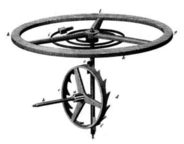
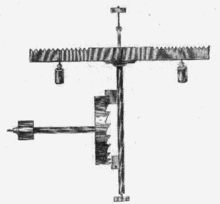
The verge (or crown wheel) escapement is the earliest known type of mechanical escapement, the mechanism in a mechanical clock that controls its rate by allowing the gear train to advance at regular intervals or 'ticks'. Its origin is unknown. Verge escapements were used from the 14th century until the mid 19th century in clocks and pocketwatches. The name verge comes from the Latin virga, meaning stick or rod.[1]
Its invention is important in the history of technology, because it made possible the development of all-mechanical clocks. This caused a shift from measuring time by continuous processes, such as the flow of liquid in water clocks, to repetitive, oscillatory processes, such as the swing of pendulums, which had the potential to be more accurate.[2][3] Oscillating timekeepers are used in all modern timepieces.
Verge and foliot clocks
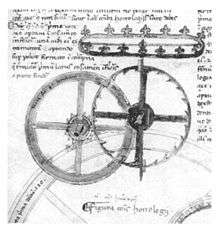
The verge escapement dates from 13th-century Europe, where its invention led to the development of the first all-mechanical clocks.[3][5][6] Starting in the 13th century, large tower clocks were built in European town squares, cathedrals, and monasteries. They kept time by using the verge escapement to drive a horizontal bar with weights on the ends called the foliot, a primitive type of balance wheel, to oscillate back and forth. The rate of the clock could be adjusted by sliding the weights in or out on the foliot bar.
The verge probably evolved from the alarum, which used the same mechanism to ring a bell and had appeared centuries earlier.[7][8] There has been speculation that Villard de Honnecourt invented the verge escapement in 1237 with an illustration of a strange mechanism to turn an angel statue to follow the sun with its finger,[9][10] but the consensus is that this was not an escapement.[11][12][13][14][15][16]
It is believed that sometime in the late 13th century the verge escapement mechanism was applied to tower clocks, creating the first mechanical clock. In spite of the fact that these clocks were celebrated objects of civic pride which were written about at the time, it may never be known when the new escapement was first used. This is because it has proven difficult to distinguish from the meager written documentation which of these early tower clocks were mechanical, and which were water clocks; the same Latin word, horologe, was used for both.[17] None of the original mechanisms have survived unaltered. Sources differ on which was the first clock 'known' to be mechanical, depending on which manuscript evidence they regard as conclusive. One candidate is the Dunstable Priory clock in Bedfordshire, England built in 1283, because accounts say it was installed above the rood screen, where it would be difficult to replenish the water needed for a water clock.[18] Another is the clock built at the Palace of the Visconti, Milan, Italy, in 1335.[19] However, there is agreement that mechanical clocks existed by the late 13th century.[3][17][20]
The earliest description of an escapement, in Richard of Wallingford's 1327 manuscript Tractatus Horologii Astronomici on the clock he built at the Abbey of St. Albans, was not a verge, but a variation called a 'strob' escapement.[21][22] It consisted of a pair of escape wheels on the same axle, with alternating radial teeth. The verge rod was suspended between them, with a short crosspiece that rotated first in one direction and then the other as the staggered teeth pushed past. Although no other example is known, it is possible that this design preceded the verge in clocks.[21]
For the first two hundred years or so of the clock's existence, the verge was the only escapement used in mechanical clocks. In the sixteenth century alternative escapements started to appear, but the verge remained the most used escapement for 350 years until mid-17th century advances in mechanics, which also resulted in the invention of the pendulum. [23] Since clocks were valuable, after the invention of the pendulum many verge clocks were rebuilt to use this more accurate timekeeping technology, so very few of the early verge and foliot clocks have survived unaltered to the present day.
How accurate the first verge and foliot clocks were is debatable, with estimates of one to two hours error per day[24] being mentioned, although more recent evidence based sources mention achievable accuracies of minutes per day.[25][26] Early verge clocks were probably no more accurate than the previous water clocks,[27] but they did not freeze in winter and were a more promising technology for innovation. By the mid-17th century, when the pendulum replaced the foliot, the best verge and foliot clocks had achieved an accuracy of 15 minutes per day.
Verge pendulum clocks
Most of the gross inaccuracy of the early verge and foliot clocks was not due to the escapement itself, but to the foliot oscillator. The first use of pendulums in clocks around 1656 suddenly increased the accuracy of the verge clock from hours a day to minutes a day . Most clocks were rebuilt with their foliots replaced by pendulums,[28][29] to the extent that it is difficult to find original verge and foliot clocks intact today. A similar increase in accuracy in verge watches followed the introduction of the balance spring in 1658.
How it works
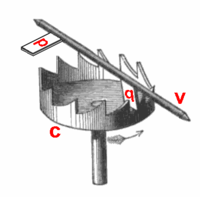

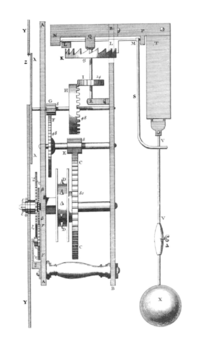
The verge escapement consists of a wheel shaped like a crown, with sawtooth-shaped teeth protruding axially toward the front, and with its axis oriented horizontally.[30] In front of it is a vertical rod, the verge, with two metal plates, the pallets, that engage the teeth at opposite sides of the crown wheel. The pallets are not parallel, but are oriented with an angle in between them so only one catches the teeth at a time. The balance wheel (or the pendulum) is mounted at the end of the verge rod. As the clock's gears turn the crown wheel, one of its teeth pushes on a pallet, rotating the verge in one direction, and rotating the second pallet into the path of the teeth on the opposite side of the wheel, until the tooth pushes past the first pallet. Then a tooth on the wheel's opposite side contacts the second pallet, rotating the verge back the other direction, and the cycle repeats. The result is to change the rotary motion of the wheel to an oscillating motion of the verge. Each swing of the foliot or pendulum thus allows one tooth of the escape wheel to pass, advancing the wheel train of the clock by a fixed amount, moving the hands forward at a constant rate.
The crown wheel must have an odd number of teeth for the escapement to function.[30] With an even number, two opposing teeth will contact the pallets at the same time, jamming the escapement. The usual angle between the pallets was 90° to 105°,[30] resulting in a foliot or pendulum swing of around 80° to 100°. In order to reduce the pendulum's swing to make it more isochronous, the French used larger pallet angles, upwards of 115°.[30] This reduced the pendulum swing to around 50° and reduced recoil (below), but required the verge to be located so near the crown wheel that the teeth fell on the pallets very near the axis, reducing initial leverage and increasing friction, thus requiring lighter pendulums.[30][31]
Disadvantages
As might be expected from its early invention, the verge is the most inaccurate of the widely used escapements. It suffers from these problems:
- Verge watches and clocks are sensitive to changes in the drive force; they slow down as the mainspring unwinds.[30] This is called lack of isochronism. It was much worse in verge and foliot clocks due to the lack of a balance spring, but is a problem in all verge movements. In fact, the standard method of adjusting the rate of early verge watches was to alter the force of the mainspring.[32] The cause of this problem is that the crown wheel teeth are always pushing on the pallets, driving the pendulum (or balance wheel) throughout its cycle; it is never allowed to swing freely.[30] All verge watches and spring driven clocks required fusees to equalize the force of the mainspring to achieve even minimal accuracy.
- The escapement has "recoil", meaning that the momentum of the foliot or pendulum pushes the crown wheel backward momentarily, causing the clock's wheel train to move backward, during part of its cycle.[30] This increases friction and wear, resulting in inaccuracy. One way to tell whether an antique watch has a verge escapement is to observe the second hand closely; if it moves backward a little during each cycle, the watch is a verge. This is not necessarily the case in clocks, as there are some other pendulum escapements which exhibit recoil.
- In pendulum clocks, the wide pendulum swing angles of 80°-100° required by the verge cause an additional lack of isochronism due to circular error.
- The wide pendulum swings also cause a lot of air friction, reducing the accuracy of the pendulum, and requiring a lot of power to keep it going, increasing wear.[7] So verge pendulum clocks had lighter bobs, which reduced accuracy.
- Verge timepieces tend to accelerate as the crown wheel and the pallets wear down. This is particularly evident in verge watches from the mid-18th century onwards. It is not in the least unusual for these watches, when run today, to gain many hours per day, or to simply spin as if there were no balance present. The reason for this is that as new escapements were invented, it became the fashion to have a thin watch. To achieve this in a verge watch requires the crown wheel to be made very small, magnifying the effects of wear.
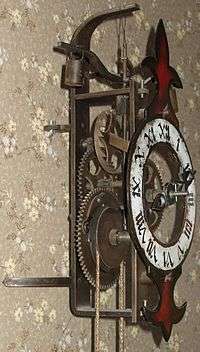
Decline
Verge escapements were used in virtually all clocks and watches for 400 years. Then the increase in accuracy due to the introduction of the pendulum and balance spring in the mid 17th century focused attention on error caused by the escapement. By the 1820s, the verge was superseded by better escapements, though many examples of mid 19th century verge watches exist, as they were much cheaper by this time.
In pocketwatches, besides its inaccuracy, the vertical orientation of the crown wheel and the need for a bulky fusee made the verge movement unfashionably thick. French watchmakers adopted the thinner cylinder escapement, invented in 1695. In England, high end watches went to the duplex escapement, developed in 1782, but inexpensive verge fusee watches continued to be produced until the mid 19th century, when the lever escapement took over.[33][34] These later verge watches were colloquially called 'turnips' because of their bulky build.
The verge was only used briefly in pendulum clocks before it was replaced by the anchor escapement, invented around 1660 and widely used beginning in 1680. The problem with the verge was that it required the pendulum to swing in a wide arc of 80° to 100°. Christiaan Huygens in 1674 showed that a pendulum swinging in a wide arc is an inaccurate timekeeper, because its period of swing is sensitive to small changes in the drive force provided by the clock mechanism.
Although the verge is not known for accuracy, it is capable of it. The first successful marine chronometers, H4 and H5, made by John Harrison in 1759 and 1770, used verge escapements with diamond pallets.,[7][35][36] In trials they were accurate to within a fifth of a second per day.[37]
Today the verge is seen only in antique or antique-replica timepieces. Many original bracket clocks have their Victorian-era anchor escapement conversions undone and the original style of verge escapement restored. Clockmakers call this a verge reconversion.
See also
- Galileo's escapement - the first proposed pendulum clock escapement by Galileo Galilei.
- Salisbury cathedral clock—oldest known operating clock, with verge and foliot escapement.
- Dover Castle Clock old known operating clock with its original verge and foliot escapement.
Notes
- ↑ Harper, Douglas (2001). "Verge". Online Etymology Dictionary. Retrieved 2008-06-22.
- ↑ Marrison, Warren (1948). "The Evolution of the Quartz Crystal Clock". Bell System Technical Journal. 27: 510–588. doi:10.1002/j.1538-7305.1948.tb01343.x. Retrieved 2007-06-06.
- 1 2 3 Cipolla, Carlo M. (2004). Clocks and Culture, 1300 to 1700. W.W. Norton & Co. ISBN 0-393-32443-5., p.31
- ↑ North, John David (2005). God's Clockmaker: Richard of Wallingford and the Invention of Time. London, UK: Hambledon & London. pp. 179, fig.33. ISBN 1-85285-451-0.
- ↑ "Escapement". Encyclopædia Britannica online. 2007. Retrieved 2007-10-26.
- ↑ White, Lynn, Jr. (1962). Medieval Technology and Social Change. UK: Oxford Univ. Press. p. 119.
- 1 2 3 Headrick, Michael (2002). "Origin and Evolution of the Anchor Clock Escapement". Control Systems magazine. Inst. of Electrical and Electronic Engineers. 22 (2). Archived from the original on 2009-10-25. Retrieved 2007-06-06.
- ↑ Dohrn-van Rossum, Gerhard (1996). History of the Hour: Clocks and Modern Temporal Orders. Univ. of Chicago Press. ISBN 0-226-15511-0., p.103-104
- ↑ MS. 19093, folio 44, French Collection, Bibliothèque Nationale, Paris (No. 1104 Library of Saint-Germain-des Prés until c.1800). Villard_de_Honnecourt_-_Sketchbook_-_44.jpg is an image of the page on Wikimedia Commons
- ↑ John H. Lienhard (2000). "The First Mechanical Clocks". The Engines of Our Ingenuity. Episode 1506http://www.uh.edu/engines/epi1506.htm
|transcripturl=missing title (help). NPR. KUHF-FM Houston. - ↑ Scheller, Robert Walter (1995). Exemplum: Model-book Drawings and the Practice of Artistic Transmission in the Middle Ages (ca. 900-ca. 1470). Amsterdam University Press. p. 185. ISBN 9053561307., footnote 7
- ↑ Barnes, Carl F. (2009). The Portfolio of Villard de Honnecourt (Paris, Bibliothèque Nationale de France, MS Fr 19093). Ashgate Publishing Ltd. p. 159. ISBN 0754651029.
- ↑ Needham, Joseph , ,; Wang, Ling; de Solla Price, Derek John (1986). Heavenly Clockwork: The Great Astronomical Clocks of Medieval China. CUP Archive. p. 195. ISBN 0521322766., footnote 3
- ↑ Needham, Joseph (1965). Science and Civilisation in China: Volume 4, Physics and Physical Technology, Part 2, Mechanical Engineering. Cambridge University Press. p. 443. ISBN 0521058031.
- ↑ White, Lynn Townsend (1964). Medieval Technology and Social Change. Oxford Univ. Press. p. 173. ISBN 0195002660.
- ↑ Dohrn-van Rossum, Gerhard (1996). History of the Hour: Clocks and Modern Temporal Orders. University of Chicago Press. pp. 105–106. ISBN 0226155102.
- 1 2 White 1966, p.124
- ↑ Luxford, Julian M. (2005). The Art And Architecture of English Benedictine Monasteries, 1300-1540. Boydell Press. pp. 209–210. ISBN 1843831538.
- ↑ Usher, Abbot Payson (1988). A History of Mechanical Inventions. Courier Dover. ISBN 0-486-25593-X., p.196
- ↑ Whitrow 1989, p.104
- 1 2 North, John David (2005). God's Clockmaker: Richard of Wallingford and the Invention of Time. UK: Hambledon & London. pp. 175–183. ISBN 1-85285-451-0.
- ↑ Dohrn-van Rossum, Gerhard (1996). History of the Hour: Clocks and Modern Temporal Orders. Univ. of Chicago Press. pp. 50–52. ISBN 0-226-15511-0.
- ↑ Fraser, Julius Thomas (1987). Time, the Familiar Stranger. Univ of Massachusetts Press. p. 53. ISBN 0870235761.
- ↑ Milham, Willis I. (1945). Time and Timekeepers. New York: MacMillan. p. 83. ISBN 0-7808-0008-7.
- ↑ W. Houtkooper "The Accuracy of the Foliot" Antiquarian Horology Vol. 20 No. One, Spring 1992
- ↑ M. Maltin "Some notes on the Medieval Clock in Salisbury Cathedral" Antiquarian Horology Vol. 20 No. 5, Spring 1993
- ↑ Lienhard, John H. "No. 1506: The First Mechanical Clocks". Engines of our Ingenuity radio program. Houston Public Media, Univ. of Houston, Houston, Texas. Retrieved July 23, 2014. External link in
|work=(help) - ↑ "Big Clocks". Science Museum, UK. 2007. Retrieved 2007-06-06.
- ↑ Milham 1945, p.144
- 1 2 3 4 5 6 7 8 Glasgow, David (1885). Watch and Clock Making. London: Cassell & Co. pp. 124–126.
- ↑ Britten, Frederick J. (1896). The Watch and Clock Maker's Handbook, 9th Ed. London: E.F. & N. Spon., p.391-392
- ↑ Perez, Carlos (2001). "Artifacts of the Golden Age, part 1". Carlos's Journal. TimeZone. Retrieved 2007-06-06.
- ↑ Perez 2001, pp.8
- ↑ Second Time Around 2007
- ↑ Perez 2001, pp.11
- ↑ Hird, Jonathan R., Betts, Jonathan D. & Pratt, D. The Diamond Pallets of John Harrison's Longitude Timekeeper–H4. Annals of Science, volume 65, Issue 2, April 2008, pg 171-200
- ↑ "A Walk Through Time, part 3: A Revolution in Timekeeping". NIST. 2002. Archived from the original on 2007-05-28. Retrieved 2007-06-06.
External links
- Weight Driven Clock Encyclopædia Britannica article has animation showing operation of a verge and foliot.
- Drawing of verge and foliot on commercial website
- Elytra Design, Diagram of verge and foliot escapement on commercial website
- Mark Frank (2005), The Evolution of Tower Clock Movements Paper with much technical information on early verge clocks by tower clock restorer, with many unique pictures of movements, references.